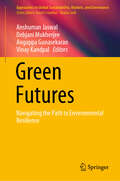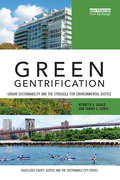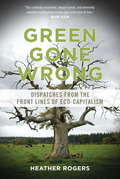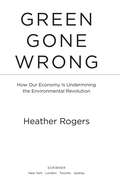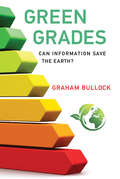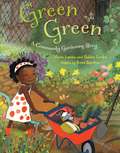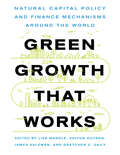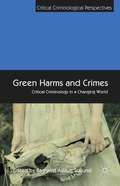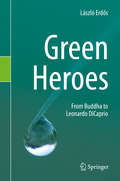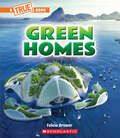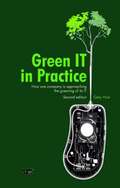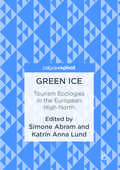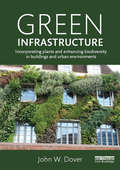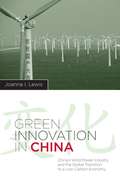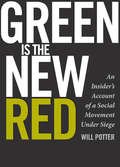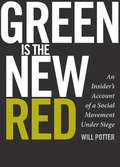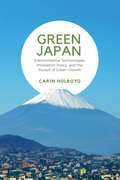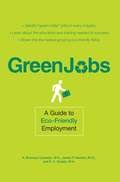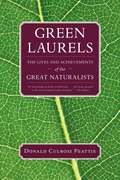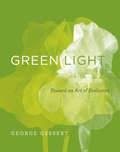- Table View
- List View
Green Futures: Navigating the Path to Environmental Resilience (Approaches to Global Sustainability, Markets, and Governance)
by Angappa Gunasekaran Debjani Mukherjee Vinay Kandpal Anshuman JaswalThis book presents a comprehensive examination of the complex journey toward achieving environmental resilience in the twenty-first century. It brings together leading voices from various fields to showcase the challenges and promising solutions in sustainability and green futures. Organized into thematic divisions, each chapter presents a different facet of environmental resilience, offering incisive analysis, creative techniques, and case studies from around the globe. The book explores the complex intersections of environmental, social, and economic elements, including climate change mitigation and adaptation, sustainable urban development, biodiversity conservation, and renewable energy technology. Contributions from distinguished scholars, policymakers, activists, and practitioners encourage interdisciplinary discourse and collaboration to address urgent environmental challenges. The book inspires readers to envision and actively contribute to a more sustainable and resilient future through rigorous research, visionary thinking, and practical ideas. Combining intellectual rigor with approachable prose, this book serves as an invaluable resource for students, scholars, policymakers, and anyone committed to creating a greener and more resilient society. It provides vital information and inspiration for navigating the path toward environmental resilience, whether dealing with the complexity of climate change, seeking innovative solutions for sustainable development, or advocating for environmental justice.
Green Gentrification: Urban sustainability and the struggle for environmental justice (Routledge Equity, Justice and the Sustainable City series)
by Tammy L. Lewis Kenneth A. GouldGreen Gentrification looks at the social consequences of urban "greening" from an environmental justice and sustainable development perspective. Through a comparative examination of five cases of urban greening in Brooklyn, New York, it demonstrates that such initiatives, while positive for the environment, tend to increase inequality and thus undermine the social pillar of sustainable development. Although greening is ostensibly intended to improve environmental conditions in neighborhoods, it generates green gentrification that pushes out the working-class, and people of color, and attracts white, wealthier in-migrants. Simply put, urban greening "richens and whitens," remaking the city for the sustainability class. Without equity-oriented public policy intervention, urban greening is negatively redistributive in global cities. This book argues that environmental injustice outcomes are not inevitable. Early public policy interventions aimed at neighborhood stabilization can create more just sustainability outcomes. It highlights the negative social consequences of green growth coalition efforts to green the global city, and suggests policy choices to address them. The book applies the lessons learned from green gentrification in Brooklyn to urban greening initiatives globally. It offers comparison with other greening global cities. This is a timely and original book for all those studying environmental justice, urban planning, environmental sociology, and sustainable development as well as urban environmental activists, city planners and policy makers interested in issues of urban greening and gentrification.
Green Goes with Everything
by Sloan BarnettImagine if your best friend gave you vital information that could protect you and your family, and save you money, and help the planet. Imagine if you were given clear, simple choices, small changes that could have a big impact on your life. And you could still wear leather shoes and deodorant. You'd listen, right? Well, think of Today show contributor Sloan Barnett as that friend. A mother of three, a dedicated consumer advocate, Sloan gives us a fast, simple, down-toearth primer on the ways our homes are making us sick, and what we can all do to transform them into the safe sanctuaries we want and need them to be. Sloan exposes the toxic truth behind the household products we use every day -- from laundry detergent to toothpaste to lipstick. She explains how these and other seemingly benign stuff can harm us and our children. She offers an array of alternatives, and inspires us to see that we're never helpless: Every day, we have the power to make better, smarter, safer choices. Packed with common sense and sass, product picks and practical tips, Green Goes With Everything is for everyone who wants to live a healthier life.
Green Gone Wrong
by Heather RogersIn Green Gone Wrong environmental writer Heather Rogers blasts through the marketing buzz of big corporations and asks a simple question: Do today's much-touted "green" products--carbon offsets, organic food, biofuels, and eco-friendly cars and homes--really work? Implicit in efforts to go green is the promise that global warming can be stopped by swapping out dirty goods for "clean" ones. But can earth-friendly products really save the planet? This far-reaching, riveting narrative explores how the most readily available solutions to environmental crisis may be disastrously off the mark. Rogers travels the world tracking how the conversion from a "petro" to a "green" society affects the most fundamental aspects of life--food, shelter, and transportation. Reporting from some of the most remote places on earth, Rogers uncovers shocking results that include massive clear-cutting, destruction of native ecosystems, and grinding poverty. Relying simply on market forces, people with good intentions wanting to just "do something" to help the planet are left feeling confused and powerless.Green Gone Wrong reveals a fuller story, taking the reader into forests, fields, factories, and boardrooms around the world to draw out the unintended consequences, inherent obstacles, and successes of eco-friendly consumption. What do the labels "USDA Certified Organic" and "Fair Trade" really mean on a vast South American export-driven organic farm? A superlow-energy "eco-village" in Germany's Black Forest demonstrates that green homes dramatically shrink energy use, so why aren't we using this technology in America? The decisions made in Detroit's executive suites have kept Americans driving gas-guzzling automobiles for decades, even as U.S. automakers have European models that clock twice the mpg. Why won't they sell these cars domestically? And what does carbon offsetting really mean when projects can so easily fail? In one case thousands of trees planted in drought-plagued Southern India withered and died, releasing any CO2 they were meant to neutralize. Expertly reported, this gripping exposé pieces together a global picture of what's happening in the name of today's environmentalism. Green Gone Wrong speaks to anyone interested in climate change and the future of the natural world, as well as those who want to act but are caught not knowing who, or what, to believe to protect the planet. Rogers casts a sober eye on what's working and what's not, fearlessly pushing ahead the debate over how to protect the planet.
Green Gone Wrong: How Our Economy Is Undermining the Environmental Revolution
by Heather RogersIn Green Gone Wrong environmental writer Heather Rogers blasts through the marketing buzz of big corporations and asks a simple question: Do today’s much-touted "green" products—carbon offsets, organic food, biofuels, and eco-friendly cars and homes—really work? Implicit in efforts to go green is the promise that global warming can be stopped by swapping out dirty goods for "clean" ones. But can earth-friendly products really save the planet? This far-reaching, riveting narrative explores how the most readily available solutions to environmental crisis may be disastrously off the mark. Rogers travels the world tracking how the conversion from a "petro" to a "green" society affects the most fundamental aspects of life—food, shelter, and transportation. Reporting from some of the most remote places on earth, Rogers uncovers shocking results that include massive clear-cutting, destruction of native ecosystems, and grinding poverty. Relying simply on market forces, people with good intentions wanting to just "do something" to help the planet are left feeling confused and powerless.Green Gone Wrong reveals a fuller story, taking the reader into forests, fields, factories, and boardrooms around the world to draw out the unintended consequences, inherent obstacles, and successes of eco-friendly consumption. What do the labels "USDA Certified Organic" and "Fair Trade" really mean on a vast South American export-driven organic farm? A superlow-energy "eco-village" in Germany’s Black Forest demonstrates that green homes dramatically shrink energy use, so why aren’t we using this technology in America? The decisions made in Detroit’s executive suites have kept Americans driving gas-guzzling automobiles for decades, even as U.S. automakers have European models that clock twice the mpg. Why won’t they sell these cars domestically? And what does carbon offsetting really mean when projects can so easily fail? In one case thousands of trees planted in drought-plagued Southern India withered and died, releasing any CO2 they were meant to neutralize. Expertly reported, this gripping exposé pieces together a global picture of what’s happening in the name of today’s environmentalism. Green Gone Wrong speaks to anyone interested in climate change and the future of the natural world, as well as those who want to act but are caught not knowing who, or what, to believe to protect the planet. Rogers casts a sober eye on what’s working and what’s not, fearlessly pushing ahead the debate over how to protect the planet.
Green Governance
by David Bollier Burns H. WestonThe vast majority of the world's scientists agree: we have reached a point in history where we are in grave danger of destroying Earth's life-sustaining capacity. But our attempts to protect natural ecosystems are increasingly ineffective because our very conception of the problem is limited; we treat "the environment" as its own separate realm, taking for granted prevailing but outmoded conceptions of economics, national sovereignty, and international law. Green Governance is a direct response to the mounting calls for a paradigm shift in the way humans relate to the natural environment. It opens the door to a new set of solutions by proposing a compelling new synthesis of environmental protection based on broader notions of economics and human rights and on commons-based governance. Going beyond speculative abstractions, the book proposes a new architecture of environmental law and public policy that is as practical as it is theoretically sound.
Green Grades: Can Information Save the Earth?
by Graham BullockA comprehensive assessment and analysis of the validity, trustworthiness, and effectiveness, of such environmental ratings as ENERGY STAR, LEED, and USDA Organic. Consumers are confronted with a confusing array of environmental ratings on products that range from refrigerators to shampoos. Is the information that these ratings represent trustworthy, accurate, or even relevant to environmental concerns? “Information optimists” believe that these “green grades” can play an important role in saving the planet. “Information pessimists” consider them a distraction from pursuing legislative and regulatory actions. In this book, Graham Bullock offers a comprehensive assessment and analysis of the effectiveness and validity of such environmental ratings as ENERGY STAR, USDA Organic, the Forest Stewardship Council, LEED, and the Toxic 100 Air Polluters Index. Bullock stakes out a position as an “information realist,” acknowledging both the contributions and the limitations of these initiatives. Drawing on interviews, case studies, and an original dataset of 245 environmental ratings and certifications, he examines what he calls the information value chain of green grades: organizational associations, content, methods, interfaces, and outcomes. He explores the relevance of the information to the issues; the legitimacy and accountability of sponsoring or cooperating organizations; the reliability of methods used to develop the information; the prominence and intelligibility of communication to the public; and the effects and effectiveness of the information after it emerges from the value chain. Bullock's analysis offers a realistic appraisal of the role of information-based environmental governance—its benefits and shortcomings—and its relation to other governance strategies.
Green Green: A Community Gardening Story
by Marie Lamba Baldev LambaGreen grass is wide and fresh and clean for a family to play in, and brown dirt is perfect for digging a garden. But when gray buildings start to rise up and a whole city builds, can there be any room for green space? The neighborhood children think so, and they inspire the community to join together and build a garden for everyone to share in the middle of the city.
Green Growth That Works: Natural Capital Policy and Finance Mechanisms from Around the World
by Gretchen Daily Lisa Mandle Zhiyun Ouyang James E. SalzmanRapid economic development has been a boon to human well‑being, but comes at a significant cost to the fertile soils, forests, coastal marshes, and farmland that support all life on earth. If ecosystems collapse, so eventually will human civilization. One solution is inclusive green growth—the efficient use of natural resources. Its genius lies in working with nature rather than against it. Green Growth That Works is the first practical guide to bring together pragmatic finance and policy tools that can make investment in natural capital both attractive and commonplace. Pioneered by leading scholars from the Natural Capital Project, this valuable compendium of proven techniques can guide agencies and organizations eager to make green growth work anywhere in the world.
Green Harms and Crimes
by Ragnhild Aslaug SollundThe book presents discussions of the application of Stan Cohen's theories alongside empirical contributions in the fields of critical and green criminology. Taken together, the authors critically address harms and crimes against the environment, as well as against human and nonhuman victims.
Green Heroes: From Buddha to Leonardo DiCaprio
by László ErdősThis book provides an introduction into the diversity of the environmental movement through great characters in the green sector. The book describes inspiring personal achievements, and at the same time it provides readers with information regarding the history, the main directions and the ethical principles of the environmental movement. Some of the most important characters of the movement from all around the world, are included in the book. As well as the title characters, Buddha and Leonardo DiCaprio, other famous environmentalists like Albert Schweitzer, David Attenborough and Jane Goodall are discussed. Some of the less well-known but equally important environmentalists such as Chico Mendes, Bruno Manser, Henry Spira, Tom Regan or Rossano Ercolini are highlighted in the various chapters. The selection of characters represents all major branches within the green sector, ranging from medieval saints to Hollywood celebrities, from university professors to field activists, from politicians to philosophers, from ecofeminists to radicals.
Green Homes (A True Book (Relaunch))
by Felicia BrowerEnvision a brighter future with this STEM-based subset of True Books.Small changes over the years = from smarter light bulbs to energy-efficient appliances = have made our homes more environmentally friendly. In recent years we have learned how to make alternative energies and Earth-friendly building methods and materials a reality. Today we understand how to build green homes = dwellings that have zero negative impact on the environment. Green Homes will show you how.ABOUT THE SERIES:What would a green future look like? Will trains and airplanes be powered by the sun? Will we have homes that have zero impact on the environment? The most pressing challenge facing us today is how to ensure a healthy Earth for ourselves and future generations. This STEM-based set of A True Books introduces students to the engineering innovations that can help us reach those goals. Interesting information is presented in a fun, friendly way = and in the simplest terms possible = and will inspire kids to start envisioning and enacting a more sustainable future.
Green IT in Practice
by Gary HirdOrganisations are becoming increasingly concerned about climate change, and are looking for ways to reduce their environmental impact. A brand with a genuine commitment to the green agenda will be more valued by its customers, and cutting energy consumption means that your business can also cut costs. The IT department has a vital role to play in minimising the carbon footprint of your organisation. Green IT in Practice, Second edition provides guidance on how to implement a Green IT programme. It will help you to formulate a Green IT policy, curb demand for data storage capacity, and lower the electricity consumption of the datacentre. A specific chapter looks at how server and desktop virtualisation can enable your business to save energy and space. Based on his first-hand experience of successfully implementing Green IT initiatives for the John Lewis Partnership, the author describes the specific problems that JLP confronted, and explains the solutions that he found for them. He gives a fascinating account of how Green IT has enabled one of Britain's best-loved companies to make significant improvements in efficiency. This second edition has been updated to reflect the progress that JLP's Green IT programme has made since 2008. The author shows how IT can be harnessed to help reduce carbon emissions across the whole organisation, pointing to the success of IT initiatives at Waitrose in improving demand forecasting and reducing food miles.
Green Ice
by Simone Abram Katrín Anna LundThis book presents lively case studies of tourism developments in the European High North from diverse perspectives. It compares views of the changing political ecology of a fragile region shaped by climatic and cultural factors. In exploring the mutual relations between new developments in Arctic travel narratives and tourism practices. Green Ice: Tourism Ecologies in the European High North pays particular attention to the changing discourses that produce, and are in turn produced by, encounters between contemporary Arctic peoples and territories. Questions of gender and nationality are considered alongside a comparison of texts and practices in different languages, examining the politics of language and its significant role in tourism. This title pays attention to the changing symbolic value of Arctic discourses in environmental movements, in order to consider the close connections between global forms of environmentalist discourse and action and local cultural responses. An engaging and timely work, this book will be of great interest to scholars of Geography, Anthropology, and Arctic Tourism.
Green Infrastructure: Incorporating Plants and Enhancing Biodiversity in Buildings and Urban Environments (Routledge Studies in Urban Ecology)
by John W. DoverWith more than half of the world's population now living in urban areas, it is vitally important that towns and cities are healthy places to live. The principal aim of this book is to synthesize the disparate literature on the use of vegetation in the built environment and its multifunctional benefits to humans. The author reviews issues such as: contact with wildlife and its immediate and long-term effects on psychological and physical wellbeing; the role of vegetation in removing health-damaging pollutants from the air; green roofs and green walls, which provide insulation, reduce energy use and decrease the carbon footprint of buildings; and structural vegetation such as street trees, providing shading and air circulation whilst also helping to stop flash-floods through surface drainage. Examples are used throughout to illustrate the practical use of vegetation to improve the urban environment and deliver ecosystem services. Whilst the underlying theme is the value of biodiversity, the emphasis is less on existing high-value green spaces (such as nature reserves, parks and gardens), than on the sealed surfaces of urban areas (building surfaces, roads, car parks, plazas, etc.). The book shows how these, and the spaces they encapsulate, can be modified to meet current and future environmental challenges including climate change. The value of existing green space is also covered to provide a comprehensive textbook of international relevance.
Green Innovation in China
by Joanna I LewisAs the greatest coal producing and consuming nation in the world, China would seem an unlikely haven for wind power. Yet the country now boasts a world-class industry that promises to make low-carbon technology more affordable and available to all. Conducting an empirical study of China's remarkable transition and the possibility of replicating their model elsewhere, Joanna I. Lewis adds greater depth to a theoretical understanding of China's technological innovation systems and the country's current and future role in a globalized economy.Lewis focuses on China's specific methods of international technology transfer, its forms of international cooperation and competition, and its implementation of effective policies that promoted the development of a home-grown industry. Just a decade ago, China claimed only a handful of operating wind turbines-all imported from Europe and the United States. Today, the country is the largest wind power market in the world, with turbines made almost exclusively in its own factories. Studying this shift reveals how China's political leaders have responded to domestic energy challenges and how they may confront climate change. The nation's ability to escalate its use of wind power also demonstrates China's ability to leapfrog to cleaner energy technologies-a path equally viable for other developing countries hoping to bypass gradual industrialization and the "technological lock-in" of hydrocarbon-intensive energy infrastructure. Though setbacks are possible, China could come to dominate global wind turbine sales, becoming a hub of technological innovation and a major instigator of low-carbon economic change.
Green Innovation in China: China's Wind Power Industry and the Global Transition to a Low-Carbon Economy (Contemporary Asia in the World)
by Joanna LewisAs the greatest coal-producing and consuming nation in the world, China would seem an unlikely haven for wind power. Yet the country now boasts a world-class industry that promises to make low-carbon technology more affordable and available to all. Conducting an empirical study of China's remarkable transition and the possibility of replicating their model elsewhere, Joanna I. Lewis adds greater depth to a theoretical understanding of China's technological innovation systems and its current and future role in a globalized economy. Lewis focuses on China's specific methods of international technology transfer, its forms of international cooperation and competition, and its implementation of effective policies promoting the development of a home-grown industry. Just a decade ago, China maintained only a handful of operating wind turbines—all imported from Europe and the United States. Today, the country is the largest wind power market in the world, with turbines made almost exclusively in its own factories. Following this shift reveals how China's political leaders have responded to domestic energy challenges and how they may confront encroaching climate change. The nation's escalation of its wind power use also demonstrates China's ability to leapfrog to cleaner energy technologies—an option equally viable for other developing countries hoping to bypass gradual industrialization and the "technological lock-in" of hydrocarbon-intensive energy infrastructure. Though setbacks are possible, China could one day come to dominate global wind turbine sales, becoming a hub of technological innovation and a major instigator of low-carbon economic change.
Green Is the New Red
by Will PotterAt a time when everyone is going green, most people are unaware that the FBI is using anti-terrorism resources to target environmentalists. Here is a guided tour into an underground world of radical activism and an introduction to the shadowy figures behind the headlines. But here also is the story of how everyday people are prevented from speaking up for what they believe in. Like the Red Scare, this "Green Scare" is about fear and intimidation, and Will Potter outlines the political, legal, and public relations strategies that threaten even acts of nonviolent civil disobedience with the label of "eco-terrorism."
Green Is the New Red: An Insider's Account of a Social Movement Under Siege
by Will PotterAn insider tells how environmentalists and animal rights activists have become "the number one domestic terrorism threat."
Green Japan: Environmental Technologies, Innovation Policy, and the Pursuit of Green Growth
by Carin HolroydAs climate change continues to threaten both our economic and ecological well-being, countries around the world are trying to implement green strategies that will simultaneously curb emissions and spur economic growth. Green Japan critically examines the Japanese effort to combine economic growth with commitments to environmental sustainability. Carin Holroyd explores green growth strategies in various industries including conservation, energy, urban development, and international trade. Holroyd’s comprehensive analysis of how innovation strategies connect with environmental priorities combines a detailed study of government policies with insightful assessments of consumer and market responses. The unevenness of Japan’s success clearly demonstrates the exceptional technological innovation and creative public policy initiatives that are needed in order to successfully reverse the effects of climate change. Green Japan offers a nuanced and hopeful account of one nation’s attempts at linking environmental sustainability and continued prosperity.
Green Jobs: A Guide to Eco-friendly Employment
by A. Bronwyn Llewellyn James P. Hendrix K. C. GoldenThe first green employment guide from America's #1 career publisher features profiles of hundreds of lucrative positions. With this comprehensive guide, readers can find the job of their dreams--and know they're making a difference.
Green Jobs: A Guide to Eco-friendly Employment
by A. Bronwyn Llewellyn James P. Hendrix K. C. GoldenGreen Jobs will help you to find a job you like--and that'll make the world a better place.
Green Laurels
by Donald Culross PeattieIn Green Laurels, Donald Culross Peattie combines his extensive knowledge of history's foremost naturalists with his personal observations about the subject to form what the New York Herald Tribune calls "a delightful book...one would not wish to miss on any account." This piece is accurate and precise but according to Nation, "there is not a line which is not dramatically vivid and entertaining." Peattie's enthusiasm and enlightened curiosity make Green Laurels appealing to readers of all backgrounds.
Green Laurels
by Donald Culross PeattieIn Green Laurels, Donald Culross Peattie combines his extensive knowledge of history's foremost naturalists with his personal observations about the subject to form what the New York Herald Tribune calls "a delightful book...one would not wish to miss on any account." This piece is accurate and precise but according to Nation, "there is not a line which is not dramatically vivid and entertaining." Peattie's enthusiasm and enlightened curiosity make Green Laurels appealing to readers of all backgrounds.
Green Light: Toward an Art of Evolution (Leonardo)
by George GessertHow humans' aesthetic perceptions have shaped other life forms, from racehorses to ornamental plants.Humans have bred plants and animals with an eye to aesthetics for centuries: flowers are selected for colorful blossoms or luxuriant foliage; racehorses are prized for the elegance of their frames. Hybridized plants were first exhibited as fine art in 1936, when the Museum of Modern Art in New York showed Edward Steichen's hybrid delphiniums. Since then, bio art has become a genre; artists work with a variety of living things, including plants, animals, bacteria, slime molds, and fungi. Many commentators have addressed the social and political concerns raised by making art out of living material. In Green Light, however, George Gessert examines the role that aesthetic perception has played in bio art and other interventions in evolution. Gessert looks at a variety of life forms that humans have helped shape, focusing on plants—the most widely domesticated form of life and the one that has been crucial to his own work as an artist. We learn about pleasure gardens of the Aztecs, cultivated for intoxicating fragrance; the aesthetic standards promoted by national plant societies; a daffodil that looks like a rose; and praise for weeds and wildflowers.
